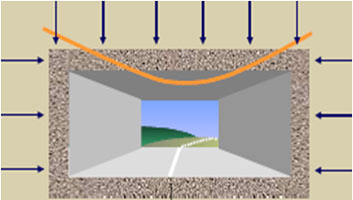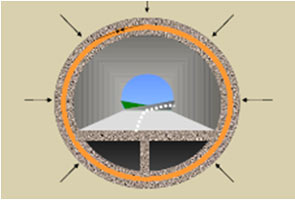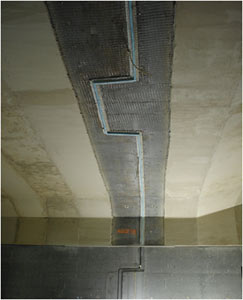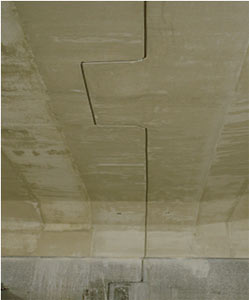NEW PRODUCTS and INNOVATIONS
Fire protection for Oslo's immersed tube Nov 2009
Fire protection for Oslo's immersed tube Nov 2009
-
Norway has built its first immersed tube road tunnel to realign heavy traffic across the foreshore of its capital city, Oslo. To prepare the 1km long tunnel to withstand potentially fierce fires cause by possible traffic accidents in the confined space, the client conducted rigorous tests before selecting the pre-qualified fire protection system. Albert Benhamou of Innovative Fire Systems explains the testing process.
-

Norway's first immersed tube road tunnel
- When designing tunnel linings, building design rules, such as Eurocodes, are often used. Generally the temperature within the concrete is calculated, which in turn gives the load-bearing capacity. These calculations work well for many applications but they have their limits. In standard EN 19992-1-2, covering the Eurocodes for concrete structures, the material models are only valid for heating rates of between 2 and 50°C/min. This is so because creep effects are not explicitly considered. In Norway, authorities consider that this gives erroneous results. For the country's Bjørvika immersed tube tunnel in Oslo, they preferred to model their linings with faster heating rates, using the Dutch RWS time-temperature curves which have maximum heating rates of 200-240°C/min.
- To determine the most appropriate fire protection lining, Swedish and Norwegian authorities ran a series of fire tests on loaded concrete in 2006. Three different products were tested and the following conclusions reached. Fire-resistance, in terms of temperature response and spalling, was determined experimentally for several different qualities of concrete. Concrete reinforced with polypropylene fibers gave very good results. However, there are still questions concerning the long-term durability of these fibers, particularly in terms of frost resistance and chloride ion penetration.
-

Alignment across the foreshore
- Tests performed on concrete with certain types of protection were not satisfactory because, even though the products used displayed previously documented results, they were found to be incapable of responding to the extreme stresses of this series of tests. Under the Swedish and Norwegian study, three different systems were tested on loaded slabs of concrete with a compression force of 5.5MPa and all failed. Consequently, in June 2007, the Statens Vegvesen (the Norwegian Public Roads Administration) published a report (TR-2494) describing the method to be used for testing fire protection systems in tunnels.
- These testing methods are to be performed in accordance with the RWS fire curve while duplicating as far as possible the bending moment of their hyper-static structure, thus simulating the plastic moment created by the permanent load under rising temperature.
- The Public Roads Administration did not want to duplicate the Dutch fire test methodology for mined or bored tunnels, as these do not experience the stresses that apply to hyper-static structures.
- Fire tests for the immersed tube tunnel had to be performed on large post-stressed concrete components in a horizontal oven, with a load of 4,633kN applied to the slab to simulate a theoretical compression strength of 12.9MPa to the exposed surface.
- The Norwegian authorities used the same philosophy as the French 2000-63 recommendations of March 2005 to perform tests on large 4m x 3m loaded slabs with a load applied.
- Through these cumulative requirements for wide, loaded spans and under simulated fire of 300MW strength, we can say that the Innovative Fire Systems' Fire Barrier 135 product passed the most demanding fire test for immersed tunnels and hyper-static structures.
- For the Oslo project, fire tests had to be performed in an ISO 9001 or ISO/EIC 17025 certified laboratory. In addition a frost resistance test was required in accordance with EN 1387-1 that requires 40 cycles through a temperature range of -20°C to 10° C). The qualification process also required fatigue testing through 50 million cycles, high-pressure cleaning resistance testing at 150 bar, and alkali resistance and carbonation testing.
-

Complete with its fire protection system in the ceiling
- Innovative Fire Systems, the exclusive distributor of the spray-mortar Fire Barrier 135 system since May 2003, has signed more than 35 contracts for tunnels in France, Spain, Monaco, Italy and Egypt. For the Bjørvika project in Oslo, a manufacturer of thermal ceramics was the only other supplier to agree to undergo the series of tests, an investment of more than €150 000. The suppliers of inserted boards and vermiculite-based sprayed mortar (suppliers within the same group) did not attempt any further tests on their products following their initial failure with the test series in Malmö, Sweden in 2006.
- With 15 previous fire tests on Fire Barrier 135, performed in five different laboratories (TNO, CSI, CSTB, SINTEF, SP) and according to three different fire curves (RWS, HCinc, ISO) and on various types of concrete with compression strengths of 35MPa to 76MPa, Innovative Fire Systems, and its supplier of thermal ceramics competitor, spent a year on intensive tests to met the stringent Norwegian requirements.
- Several fire resistance, physical characterization, and longevity tests were performed at the Swedish national test and research centre at Borås. The combustible load was dimensioned for a 300MW fire lasting for at least two hours, as per the RWS curve. The surfaces were protected with a 36mm thick coating of Fire Barrier 135, reinforced with 1.9mm diameter stainless steel wire mesh, in panels of 50mm x 50mm, bound to the concrete with spacers and anchors placed at 40cm x 40cm. After two hours, the average temperature at the interface was less than 265°C.
-
The different stresses experienced by hyper-static and bored tunnel structures
- The alkali resistance test was performed according to Norwegian specifications. For fire protection testing, samples had to be hardened or conditioned for at least six weeks at 23±2°C/50±5% RH before starting the test. A set of at least five test samples was immersed for two days in 1N NaOH (1mole/litre of sodium hydroxide) at 23±2°C, flushed with distilled water and conditioned at 23±2°C/50±5% RH for at least four weeks. At the same time, another set of at least five test samples was conditioned at 23±2°C/50±5 % RH for at least four weeks without first undergoing the alkali attack.
- An adhesion test was then performed on both test sets in accordance with EN 1542:1999. The adhesion of the fire protection to the reference concrete for the Fire Barrier 135 product was not reduced by more than 20% by the effect of the alkali and the coating did not show signs of deterioration as a result of the alkali attack.
-

Application of the Fire Barrier 135 systems in an immersed tube structure
- The carbonization resistance test was performed in accordance with standard EN 13295:2004, with resistance to carbonizing as a result of reaction to CO2 produced by the traffic zone tested. The following pressure or suction dynamic forces were applied for 15 million cycles with a tear strength of 1.97kPa and a compression of 1.56kPa.
- The frost resistance test was performed in accordance with standard EN 13687-1:2002. The test ended after 50 cycles, each lasting four hours. It involved 2 hours of immersion in a tank containing a saturated sodium chloride solution at a temperature of -15±2°C, followed by 2 hours storage in a water tank at a temperature of 21±2°C.
- The fatigue test was performed according to Norwegian specifications and the fire protection system, including its mechanical anchoring systems, was tested to the relevant traffic loads in the tunnel, measured at 100,000 vehicles/day.
- The high-pressure cleaning test was also performed in accordance with Norwegian specifications.
- The fire protection system and its surfaces must tolerate normal periodic tunnel washing. To simulate total life expectancy a series of 120 cleaning operations were performed under pressure of 50 bar to 150 bar for one minute over a 1m2 surface with a water flow rate varying from 10-25 litres/minute/nozzle, and with a 500mm space between the spray nozzles and the fire protection surface. To meet customer requirements, Innovative Fire System developed an assembly of products that comprised both prefabricated products and the spray-applied Fire Barrier 135.
-

Installation works underway
- Installation operations
- Once selected for the Bjørvika Tunnel project, Innovative Fire Systems had to install more than 35,000m2 of Fire Barrier 135 before the start of autumn. To complete this the company used 60 workers and technicians. The general site organization consisted of teams for support cleaning, installing the mesh, for fitting expansion joints and thickness gauge rings, for spraying and smoothing the mortar, and for removing the rings.
- A strict quality assurance plan was implemented with measurement of mesh attachment points, tear strength testing on anchorages (100 daN/unit), support spacing for the spacers and mortar thickness measurement all monitored. Samples of the mortar were also taken to measure its density, fine loss and compression strength. In-situ adhesion tests were performed every week, which is an average four times more than the customer's requirement.
-
A expansion joint system for the project was selected after joint research between Statens Vegvesen and Innovative Fire Systems to find a solution to the sealing problems experienced in immersed tube tunnels. The system adopted:
• provides a waterstop with a maximum acceptable temperature of 80°C, with RWS constant fire exposure.
• assumes a movement due to dilation of 3.5cm in the middle of the tunnel.
• provides a high-pressure washing resistance of 150 bars.
|
|
|
|
|
Add your comment
- Thank you for taking the time to share your thoughts and comments. You share in the wider tunnelling community, so please keep your comments smart and civil. Don't attack other readers personally, and keep your language professional.






